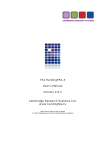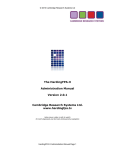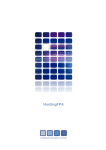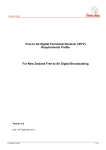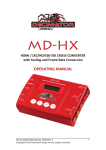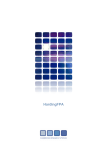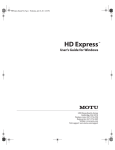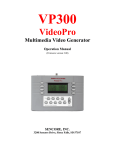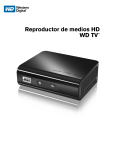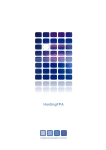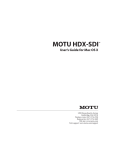Download HardingFPA-XL User`s Manual
Transcript
HardingFPA-XL User's Manual Version 2.0.0 Cambridge Research Systems Ltd. www.hardingfpa.tv Help ensure video is safe to watch for both diagnosed and dormant photosensitive epileptics © 2010 Cambridge Research Systems Ltd. Contact Details Manufactured by: Cambridge Research Systems Ltd. 80 Riverside Estate, Sir Thomas Longley Road, Rochester, Kent, ME2 4BH, England Tel: +44 (0) 1634 720707 Fax: +44 (0) 1634 720719 email: [email protected] Website: www.hardingfpa.tv Available in Japan from: Namoto Trading Co., Ltd. 1-44-1 Minami-ono, Ichikawa, CHIBA, 272-0804, Japan Tel : +81-47-338-3224 Fax :+81-47-338-3236 email: [email protected] Website: www.namoto.com Project Medical Consultant: Professor Graham Harding Applicable Version: This manual is applicable to the HardingFPA-XL Version 2.0.0 (22nd March 2010) Document Revision: 18th March 2010 HardingFPA-XL User's Manual 2 © 2010 Cambridge Research Systems Ltd. Table of Contents Overview System Requirements Accepted Video Formats Licensing Prerequisites (Mac OS X) Installation (Mac OS X) Installation (Windows) Main Screen Version 3 Analysis Algorithms Operation Opening a Source Analysing a Movie Resuming Work Replay Functions Frame Masks Analysis Information SD Legacy Mode Interpreting Results Licensing Information HardingFPA-XL User's Manual 5 6 7 8 10 11 12 13 14 20 21 23 24 25 26 29 32 33 43 3 © 2010 Cambridge Research Systems Ltd. HardingFPA-XL User's Manual 4 © 2010 Cambridge Research Systems Ltd. Overview The HardingFPA-XL is a file-based version of the HardingFPA Broadcast Flash and Pattern Analyser. It operates in a similar way, but analyses High Definition (HD, up to 1080i60) files instead of tapes. It has the ability to open many file formats including MXF, mov and AVI. It analyses using new Version 3 analysis algorithms, which have been designed specifically for HD standards and file analyses. For compatibility the software can be switched to use SD Legacy Mode, which allows SD material to be analysed using Version 2.5 analysis algorithms which are the same as in the previous 2.54/2.57 versions of the HardingFPA, and Version 1.x of the HardingFPA-X and HardingFPA-XL file-based systems. It is a limited version of the full HardingFPA-X system that is designed to run on a single computer and allow analysis of a single movie file at any one time. The HardingFPA-XL has the ability to output PDF Certificates only (although no detailed reports are available - only single page pass/fail reports). This manual covers both the Mac OS X and Windows versions of the HardingFPA-XL, which operate in an identical manner. HardingFPA-XL User's Manual 5 © 2010 Cambridge Research Systems Ltd. The HardingFPA-XL is cross platform, therefore it can run on both Windows and Mac computers. The HardingFPA-XL supports Intel powered Mac computers only, and requires Mac OS X version 10.4 or higher. Optimum performance will be obtained with multi-core processors, and at least 1 GB of RAM. The provided HASP USB software protection key will need to be inserted into the computer for the application to run, and will not operate without one. The HardingFPA-XL will analyse any movie file for which the computer it is installed on has the codec, and will attempt to open all files with the following file extensions: *.avi;*.mov;*.mpg;*.mpeg;*.m2v;*.mp4;*.vob;*.wmv;*.mxf;*.flv QuickTime Codecs are not provided with the HardingFPA-XL; therefore any required codecs will need to be installed on the computers to be used. In general, if the file can be viewed correctly using QuickTime (or QuickTime or Windows Media Player on Windows installations) on the computer that the application is running on, then it will be able to be analysed, although the video must fall within the whitelist for Accepted Video Formats. HardingFPA-XL User's Manual 6 © 2010 Cambridge Research Systems Ltd. Accepted Video Formats The HardingFPA-XL will analyse movie files with the following video formats: 1920x1080p23.98, 1920x1080p24, 1920x1080i24, 1920x1080p25, 1920x1080i25, 1920x1080p29.97, 1920x1080i29.97, 1920x1080p30, 1920x1080p50, 1920x1080i50, 1920x1080i59.94, 1920x1080p60, 1920x1080i60 1440x1080p23.98, 1440x1080p24, 1440x1080i24, 1440x1080p25, 1440x1080i25, 1440x1080p29.97, 1440x1080i29.97, 1440x1080p30, 1440x1080p50, 1440x1080i50, 1440x1080i59.94, 1440x1080p60, 1440x1080i60 1280x720p23.98, 1280x720p24, 1280x720p25, 1280x720p29.97, 1280x720p30, 1280x720p50, 1280x720p59.94, 1280x720p60 960x720p23.98, 960x720p24, 960x720p25, 960x720p29.97, 960x720p30, 960x720p50, 960x720p59.94, 960x720p60 768x576p25, 768x576i25, 768x576p27.97, 768x576i29.97 702 – 720 x 576p25, 702 – 720 x 576i25 702 – 720 x 486p29.97, 702 – 720 x 486i29.97 702 – 720 x 480p29.97, 702 – 720 x 480i29.97 640x480p29.97, 640x480i29.97 384x288p25, 384x288i25 352x288p25, 352x288i25 320x240p29.97, 320x240i29.97 In SD Legacy Mode, the HardingFPA-XL will analyse movies with the following video formats: 702 – 720 x 576p25, 702 – 720 x 576i25 702 – 720 x 486p29.97, 702 – 720 x 486i29.97 702 – 720 x 480p29.97, 702 – 720 x 480i29.97 352x288p25, 352x288i25 384x288p25, 384x288i25 320x240p29.97, 320x240i29.97 HardingFPA-XL User's Manual 7 © 2010 Cambridge Research Systems Ltd. Licensing The HardingFPA-XL must be licenced with a USB hardware protection key in order to run (see below). Once it has been run on a particular computer, it will only be allowed to run on that same computer, although there is limited scope for de-registering the product to move it to another computer (once per week). Reregistering If you move the USB protection key to a new computer and run the HardingFPA-XL, you will be given the option to transfer the licence to the new computer, as long as one week has passed since the last re-registration / first registration. The re-registration screen is shown below: Only one re-registration is possible in a week long period, so be certain that you wish to move the licence to the new computer, otherwise you will see the dialogue box below: HardingFPA-XL User's Manual 8 © 2010 Cambridge Research Systems Ltd. HardingFPA-XL User's Manual 9 © 2010 Cambridge Research Systems Ltd. Prerequisites (Mac OS X) In order for the Analyser and Licence Server parts of the server distribution to work correctly, a USB HASP key must be installed, and therefore the drivers for this must be installed. To install these, click on the HDD_Installer_MacOSX.dmg icon. The disk image for the HASP key driver installer This will then mount the disk image containing the driver installer. This screen can be seen below. Double-click on the Install HASP USB Driver icon within this image to install the driver. The HASP Installer disk image contents HardingFPA-XL User's Manual 10 © 2010 Cambridge Research Systems Ltd. Installation (Mac OS X) Before continuing, note that the HardingFPA-XL software locks itself to the current machine, but can be moved once per week. Once the prerequisites are in place, simply open the HardingFPA-XL disk image and run the installer within. The application will be installed in Applications -> HardingFPA as HardingFPA-XL. HardingFPA-XL User's Manual 11 © 2010 Cambridge Research Systems Ltd. Installation (Windows) Before continuing, note that the HardingFPA-XL software locks itself to the current machine, but can be moved once per week. The HardingFPA-XL requires the QuickTime framework in order to operate, which can be obtained from: http://www.apple.com/quicktime/download/ The Windows installer is self-contained (it inlcudes the HASP drivers and the HardingFPA-XL software). To install it, simply run the HardingFPA-XL installer. The application will be installed in the HardingFPA section of the Start Menu as HardingFPA-XL. HardingFPA-XL User's Manual 12 © 2010 Cambridge Research Systems Ltd. Main Screen Upon running the HardingFPA-XL, the main screen will be displayed. This is the main and only screen for the HardingFPA-XL and is shown below. It displays a graphical representation of the characteristics of the analysed clip, and some additional advanced diagnostic information, so that the user may quickly and efficiently view the locations of failures or cautions in the source material, and optionally play back the areas around these failures to aid in rectifying the offending material. Its appearance is similar to both the HardingFPA HD and HardingFPA-X Viewer applications. All functionality of the HardingFPA-XL is performed from this screen. The main HardingFPA-XL screen All of the buttons and sections of the HardingFPA-XL screen have help text associated with them. To see what a particular part of the interface does, simply hover the mouse cursor over the button/section. HardingFPA-XL User's Manual 13 © 2010 Cambridge Research Systems Ltd. Version 3 Analysis Algorithms The HardingFPA-XL now features new analysis algorithms, which are better tuned to High Definition and File-based work. They are better suited to subtle changes in the image data, and provide much closer results when testing the same material repurposed either into a different video format, or encoded with a different codec. The main differences between the legacy algorithms and the new ones are detailed below: Differences Between v2.5 and v3.0 Different Graph Scaling The HardingFPA-XL generates risk values using the same range as its predecessor (i.e. 0 to 3.4) but displays the graphical data using a revised vertical scale. This modified scale allocates much more vertical space for risk trace warnings and diagnostic trace steps but only displays risk traces up to the value of 3.0. Risk traces values from 3.1 to 3.4 are still logged as part of the results files but are graphically displayed capped at 3.0. (left) Version 2 and (right) Version 3 Graphing The Squiggle The HardingFPA-XL gives enhanced visual diagnostics when an incoming transition coincides with an HardingFPA-XL User's Manual 14 © 2010 Cambridge Research Systems Ltd. outgoing transition from one exactly second earlier. The new version 3 algorithms insert a squiggle (see below) to indicate when the diagnostic trace has simultaneously gained and lost a transition over the most recent second between video frames. Scene Changes (Japanese NAB Analysis only) When analysing under Japanese NAB guidelines, it is possible for the flash risk trace to go into failure while the diagnostic trace is still in the caution zone (see image). T his can occur if one of the transitions in the most recent second is classified as a “scene change” (see bottom entry of the Advanced Information tab) where 80% of the image has seen a significant luminance transition of 20IRE units or more. When this occurs, the maximum allowable number of transitions is reduced from 6 down to 3 and, in this example, failure took place when the 4th transition was detected. HardingFPA-XL User's Manual 15 © 2010 Cambridge Research Systems Ltd. Analysis Results The HardingFPA-XL gives results which are broadly similar to those generated by version 2.5. The figure below shows the results of both versions when analysing the same video input under the same guidelines: HardingFPA-XL User's Manual 16 © 2010 Cambridge Research Systems Ltd. However, the results between the two versions will not be identical. The HardingFPA-XL will, in general, be more lenient to complex, rapid motion: ... but more strict to examples of powerful, localised flashing: HardingFPA-XL User's Manual 17 © 2010 Cambridge Research Systems Ltd. Most importantly of all, the HardingFPA-XL has been designed to be as format-agnostic as possible. Changes in file formats or codecs will alter the underlying video data even if these changes are not visually apparent. Here, the same video has been encoded at the same resolution using two different codecs. The absolute differences between the two images are shown in the third image as deviations from mid grey. The new version 3 algorithms generate highly consistent results from different image resolutions and frame rates. Here, the same movie has been analysed in 720x576i50 and 640x480i60 formats with highly HardingFPA-XL User's Manual 18 © 2010 Cambridge Research Systems Ltd. consistent results. The only noticeable difference is the different horizontal graph scales as a result of the different frame rates. The graph below shows three sets of luminance flash risk results of the same movie analysed in SD-576i50, HD-720p50 and HD-1080i50 formats. The results are sufficiently similar it is difficult to see that the graph contains three separate traces: HardingFPA-XL User's Manual 19 © 2010 Cambridge Research Systems Ltd. Operation The HardingFPA-XL has three tabs available for analysing movie clips, in order to allow you to work on reviewing one piece of material whilst another is still analysing, or to work on reviewing multiple parts of an edit at the same time (if you were to analyse reference clips for example). Each tab has its own results set, and therefore its own graph etc, and operates independantly of the other tabs. Only one of these tabs may actually be in the process of analysing a clip at any one time, although after the analysis is complete, you may switch tabs and analyse another clip whilst keeping the results visible in the first tab. This is especially useful if you have a major project open and analysed in the first tab and you need to analyse clips from it in the other two tabs whilst keeping the original results visible. HardingFPA-XL User's Manual 20 © 2010 Cambridge Research Systems Ltd. Opening a Source The HardingFPA-XL operates on a system of Sources, whereby a source (a movie file) can be open, and is only analysed when the analyse button on the main window is clicked. The currently opened source is always displayed below the controls on the main window, and on startup displays Current Source: None to depict the fact that no movie file has yet been opened. To open a new source, click the Open New Source button, shown below. Clicking on the Open New Source button brings up the dialogue box shown below, where you may enter additional information in the form of the Material Description, that you require to appear on the PDF certificate. To browse for a new movie file, click on the small button labelled "..", or choose a recently selected movie file from the drop-down menu box. If you would like to clear this list at any time, click the Clear List button underneath. HardingFPA-XL User's Manual 21 © 2010 Cambridge Research Systems Ltd. When ready to analyse the movie file, click OK and the Current Source notification on the main window will change to reflect the chosen movie file name. HardingFPA-XL User's Manual 22 © 2010 Cambridge Research Systems Ltd. To start analysing the current source movie clip, click the Analysis button in the Analysis Controls section, on the left, shown below... Once the movie clip is analysing the Open new Source button will change to a Stop Analysis button. Whilst the analysis is being performed, you may still change tabs to view any results that are still open in those tabs. The small red LED light in the Analysis Controls will flash to let you know that a movie file is still being analysed. To stop the analysis, click the Stop Analysis button (the big blue square in the Analysis Controls panel). Once the analysis is complete, a basic PDF Certificate can be saved by clicking File -> Save HardingFPA Certificate. When you are finished with the clip, and wish to free up the tab for analysing other movies, click the Close Current Tab button (the cross under the graph on the right HardingFPA-XL User's Manual ). 23 © 2010 Cambridge Research Systems Ltd. Resuming Work It is possible to resume working on a particular job between sessions using the HardingFPA-XL. When the application is closed and re-opened, the open tabs are remembered by the application so that you may continue working. The settings for this are user specific, so that different user accounts may use the software and each user has their own saved tabs and results. If the application is closed during an analysis, the clip will still be re-opened, but only up to the point where the analysis was stopped. You will need to re-run the analysis if you would like to continue where this left off. Note that once the close tab button (the cross underneath the graph on the right) is clicked, there is no way to get the results back without re-analysing the movie. HardingFPA-XL User's Manual 24 © 2010 Cambridge Research Systems Ltd. Replay Functions Once results are loaded into the graph window following an analysis, the clip and graph can be played back to aid the rectification of problem areas in the clip. The Graph Controls panel underneath the graph contains buttons to facilitate this replay functionality. From left to right, the buttons perform the following function... Start Replay: Starts playback in real-time from the current position. Stop Replay: Stops all playback. Replay one second before and after current cursor position: Animate the images for one second before and one second after the current cursor position whilst leaving the graph positioned at the current cursor position. this is especially useful when you are looking for the causes of a particular failure and need to look at the graph in detail and yet still see the offending section being played back. Replay marked region: Replays from the Start marker to the End Marker. Set marker positions by either right-clicking on the graph or pressing the Page Up and Page Down keys. Zoom Out: Zoom the graph out. Zoom In: Zoom the graph in to see the results more clearly. Close Current Tab ( clip. ): Closes the results down so that the tab can then be used to analyse another In all playback modes, the playback will loop when reaching the end (after a small pause). The playback can be stopped at any time with the Stop Playback menu item or button, by clicking anywhere on the graph, by dragging the seek slider or by opening a new file. HardingFPA-XL User's Manual 25 © 2010 Cambridge Research Systems Ltd. Frame Masks The HardingFPA-XL includes new visual information in addition to the results images in the form of Frame Masks. These mask images are overlaid on top of the frame images on the large image in the top-left of the main screen and depict the locations of problem areas in the sequence, to aid in the repair of failing sequences. This mask information will only be available once the analysis is either complete or stopped, and not whilst the analysis is still taking place. When the results first appear on the graph, the large image in the top left hand side will appear as usual. In order to utilise the frame mask images, Click on the Frame Mask menu, and select the type of failure that you want to see the mask overlaid for: When any of the frame masks are chosen from this box, the images will change and the mask will be overlaid onto a darkened, black-and-white (monochrome) version of the original frame image. An example is shown below: The colours represent the number of transitions which each pixel has experienced in the most recent second after allowing for motion. The analyser will issue a failure when more than one quarter of the image contains red or purple pixels. The same colour coding (shown below) is used for both luminance and red flash analysis. HardingFPA-XL User's Manual Pixel Colour Number of Transitions none 0 green 1 or 2 yellow 3 or 4 orange 5 or 6 26 © 2010 Cambridge Research Systems Ltd. red 7 or 8 purple 9 or more The spatial pattern mask data logs the activity which exceeds the spatial guideline limits as shown below. The mask data appears as a set of uniformly coloured tiles in the image which represent how long they have persisted in the image sequence. Spatial mask data only appears for stationary, regular patterns which lead to failure. Any spatial patterns which drift, or are not regular, or do not persist in the video long enough to trigger a failure are excluded. Pixel Colour Persistence none no regular stationary pattern present green 0 to 1/6 second yellow 1/6 to 1/3 second orange 1/3 to 1/2 second red more than 1/2 second = FAILURE purple outside of pattern regularity limit The actual colours used represent how close the spatial pattern is to causing a failure rated in terms of how long the pattern has persisted in the image sequence. When running under Ofcom guidelines, the HardingFPA-XL analyser will only tolerate illegal spatial patterns to persist for up to half a second -- any longer than this will lead to a failure. Therefore the green, yellow and orange colours denote the build up to failure while red represents the actual failure itself. Purple is reserved for tiles which are part of the detected spatial pattern but whose pattern characteristics lie outside of the allowable range when compared with the rest of the spatial region. These purple tiles do not represent persistence and can accompany spatial masks of any colour. HardingFPA-XL User's Manual 27 © 2010 Cambridge Research Systems Ltd. It is important to note that the HardingFPA-XL only presents mask colours for pixels which will go into failure within the next second. This allows the editor to focus on the region(s) of the image which lead to the failure rather than flooding the user with unnecessary information. As a result, many images will contain no masked / coloured pixels even though there may be some flash or pattern activity occurring. In addition, pixel mask activity may suddenly disappear after an isolated failure sequence if the remaining pixel transition activity does not lead to a subsequent failure. HardingFPA-XL User's Manual 28 © 2010 Cambridge Research Systems Ltd. Analysis Information The table on the left hand side of the screen contains two tabs which display diagnostic information about the clip. The Analysis Summary tab shows the following pieces of information, which are applicable to the entire clip: The Analysis Summary tab Status: Shows whether the HardingFPA-XL is reviewing results or in another state such as loading/results/analysing/not loaded etc. Video Source: The video standard of the analysis being viewed. Filename: The filename or title of the source that was analysed to obtain the results currently being displayed. Analysis Timecode: The timecode of the final frame in the clip. This is expressed in hours : minutes : seconds : frames. The timecode in brackets is the amount of video stored in the disk buffer spoolfile waiting to be analysed. Marked Length: The length of material currently marked off with Begin and End markers. This is expressed in hours : minutes : seconds : frames. Recorded Length: The total length of the clip expressed in hours : minutes : seconds : frames. Analysis Status: The Pass / Fail status of the clip with respect to the currently selected Flash and Pattern guidelines. Red Flash: The number of frames that exceed the test guidelines for red flash. Spatial Patterns: The number of frames that have exceeded the test guidelines for spatial patterns. Luminance Flash: The number of frames that have exceeded the test guidelines for luminance flash. HardingFPA-XL User's Manual 29 © 2010 Cambridge Research Systems Ltd. Extended Failure: The number of frames that exceed the test guidelines for extended failure. This represents the number of frames for which the black trace has appeared or equivalently, the number of times that the maximum allowed number of flash warnings (levels 0.3 or 0.4) in the most recent 5 seconds has been exceeded. In addition to this information, there is a second tab featuring Advanced Information. This tab contains detailed information corresponding to the individual frame at the current cursor position, and may be of use in determining the build up to a failure. The items described are as follows: The Advanced Information tab Luminance Diagnostic: This is the numerical value of the diagnostic plot shown on the graph. It represents the minimum number of transitions which the most active 25% of the image frame has seen in the most recent second. Luminance Flash Area: The percentage area of the image frame which has exceeded the Flash Guidelines. Luminance Flash Contrast: The average contrast of the area of the image frame which has exceeded the Flash Guidelines. Extended Flash Warnings: The number of image frames which have generated flash warnings (levels 0.3 or 0.4) in the most recent 5 seconds. Red Diagnostic: The number of red transitions which the most active 25% of the image frame has seen in the most recent second. Red Flash Area: The percentage area of the image frame which has exceeded the Red Flash Guidelines. Red Flash Contrast: The average amplitude of flash to and from saturated red of the area of the image frame which has exceeded the Red Flash Guidelines. Spatial Pattern Area: The percentage area of the image frame which has exceeded the Spatial Pattern Guidelines. Spatial Pattern Contrast: The average contrast of the area of the image frame which has exceeded the HardingFPA-XL User's Manual 30 © 2010 Cambridge Research Systems Ltd. Spatial Pattern Guidelines. HardingFPA-XL User's Manual 31 © 2010 Cambridge Research Systems Ltd. SD Legacy Mode The HardingFPA-XL has a version 2.5 legacy option for when comparisons with earlier HardingFPA analyses are necessary. To select legacy mode, select the Settings option on the Tools menu (as a Windows administrator user, so that the Administrator settings tab is visible), check the box to enable SD Legacy Mode, and then close and restart the HardingFPA-XL application. Please note, Legacy Mode is only available for Standard Definition (SD) video analysis. All HD formats will be analysed with Version 3 analysis algorithms. Once the application is restarted, the HardingFPA-XL will only analyse in legacy mode unless the above change is reversed. The HardingFPA-XL will indicate legacy mode analysis both in the graph and on any PDF results certificate (see below). HardingFPA-XL User's Manual 32 © 2010 Cambridge Research Systems Ltd. Interpreting Results The following items are phenomena commonly seen in the results along with explanations for the behaviour. 1) A flash occurred but the normal flash risk trace didn’t appear – The main flash risk trace (dark green line) may not appear if flashing is less than 20cd/m2 in contrast or if the flash frequency is significantly within guideline limits. Remember that 2 opposing transitions make up a single flash. The example below shows that two transitions have been detected by the diagnostic trace (light green line) but that the main risk trace has not yet appeared because the flash frequency up to this point is not considered to be significant. (1) Showing a flash but no flash risk trace HardingFPA-XL User's Manual 33 © 2010 Cambridge Research Systems Ltd. 2) The flash risk trace (dark green line) appeared close to the pass-fail limit for a long sequence of images but didn’t enter the fail zone – The system has detected flashing of above 3Hz and 20cd/m2 in amplitude; but the flash area is less than 25% of the screen area. If the criteria for failure are not all met then the system will generate a line based on how close the material is to failure. If the line is hovering just below the failure line then it might only need a tiny change in size of the flashing area to push it into failure. Such a tiny change could be introduced when converting between formats, frame rates or codecs if this is not done carefully using professional grade codecs. The example below shows that the flash risk has remained close to the failure line for long enough to generate an extended flash failure. This occurs whenever more than 80% of the frames in the last five seconds generated flash risk warnings of 0.3 or 0.4 (i.e. close to failure). (2) Long sequence of flashing that eventually led to an Extended Flash Failure HardingFPA-XL User's Manual 34 © 2010 Cambridge Research Systems Ltd. 3) The flash risk trace (dark green line) persists for several frames after a flash occurred – This is perfectly normal, and arises because of the way the system has to detect flashing frequencies over the most recent second. You do not need to worry about the persistence of the flash risk traces, you need to principally examine the second before the line moves into failure, or where the diagnostics trace shows that the transition count is still rising. Once you have corrected all the causes of the line first moving into failure then the material at that point will pass the test. Note, however that lots of flashing close together will generate a much longer compound failure: the best thing to do is deal with the flashes one at a time until the material passes the test. (3) Flash graph persisting after the flash. HardingFPA-XL User's Manual 35 © 2010 Cambridge Research Systems Ltd. 4) The diagnostic transition count increased where no obvious flash had occurred – The diagnostic trace represents the number of transitions seen by the most active 25% of the screen over the most recent second. Therefore continuous image activity (e.g. localised flashing and rapid movement within the scene caused by camera pan or zoom etc) can steadily increase the number of transitions that individual pixels have seen, and when at least 25% of those have seen an extra transition will the diagnostic count increase. This can be quite tricky material to fix, and may only be possible by reducing the brightness of the image or cut down on the whole area. (4) Transition count (light green trace) increased without an obvious transition HardingFPA-XL User's Manual 36 © 2010 Cambridge Research Systems Ltd. 5) A flash clearly occurred but the diagnostic trace didn’t increase – The diagnostic trace shows the number of transitions seen in the last second of material, and transitions older than that will be discarded. This means that the diagnostic count may not always coincide with an obvious flash. For example, a visible transition in an image may not lead to a higher transition count if the pixels that see the transition are not part of the most active 25%. (5) A flash clearly occurred but the diagnostic trace hasn’t increased. Alternatively, an incoming transition may coincide with an outgoing transition from one exactly second earlier. When this occurs, the new version 3 analyser inserts a squiggle (see picture with inset) to indicate that the diagnostic trace has simultaneously gained and lost a transition over the most recent second between video frames. HardingFPA-XL User's Manual 37 © 2010 Cambridge Research Systems Ltd. 6) The spatial pattern trace remains in the pass zone even though the detected spatial pattern exceeds contrast and screen area limits – A number of limits have to be exceeded before a detected spatial pattern can generate a failure. The Advanced Information tab in the example below shows that a spatial pattern has been detected with 50 cd/m2 contrast (limit 20 cd/m2) and covers 46% screen area (limit 40%). However, in this example, the system has not generated a failure because motion, caused by the camera pan and zoom, makes the detected spatial pattern exempt from failure under Ofcom rules. HardingFPA-XL User's Manual 38 © 2010 Cambridge Research Systems Ltd. HardingFPA-XL User's Manual 39 © 2010 Cambridge Research Systems Ltd. 7) The diagnostic trace decreased within a few frames after it had increased. Shouldn’t it have taken one second for the transition to flush out? -- Not necessarily. It is true that the diagnostic trace monitors transitions over the most recent second but the most active pixels that determine this diagnostic count are, in most cases, constantly changing. The diagnostic trace will only follow this one-second pattern if the most active pixels are changing together in phase. The example below shows the diagnostic trace (light green) increasing from zero to one for a period of only two frames (around the vertical amber current frame line) before returning to zero. HardingFPA-XL User's Manual 40 © 2010 Cambridge Research Systems Ltd. 8) The system passes a stationary pattern that looks as though it should have failed – Some patterns that are clearly bar-like in one direction may also possess some local structure in the orthogonal direction. Alternatively, a pattern may not be sufficiently regular or may not have sufficient contrast throughout. Any such structure may cause the system to see fewer than 6 light-dark bars or may separate a provocative pattern into two or more regions. Either of these mechanisms can save a provocative pattern that would otherwise have failed. The spatial pattern in the example below passes because of text and foreground objects which break up the bar-like pattern into smaller irregular regions. HardingFPA-XL User's Manual 41 © 2010 Cambridge Research Systems Ltd. 9) The analyser generates spatial warnings but it’s not obvious where the pattern is! – Occasionally the spatial trace may appear when there is no obvious spatial pattern present in the video stream. The example below shows a picture of the sea generating spatial warnings caused by waves in perspective creating faint, repeating structure. Other candidates for generating unexpected spatial responses are: landscape in perspective, net curtains and reams of paper. However, it is highly unlikely that any of these scenes would actually lead to a spatial pattern failure. HardingFPA-XL User's Manual 42 © 2010 Cambridge Research Systems Ltd. Licensing Information The HardingFPA-XL uses the Silk icon set from http://www.famfamfam.com/lab/icons/silk/ Some HardingFPA-XL plugins use external libraries and make use of the following persons' or companies' code: FFmpeg: Copyright (c) 2000-2009 Fabrice Bellard, et al. http://www.ffmpeg.org/ FFmpeg is licensed under the GNU Lesser General Public Licence, which is duplicated below. The build instructions and source code for the FFmpeg libraries used in this product are included on the installation media. GNU LESSER GENERAL PUBLIC LICENSE Version 2.1, February 1999 Copyright (C) 1991, 1999 Free Software Foundation, Inc. 51 Franklin Street, Fifth Floor, Boston, MA 02110-1301 USA Everyone is permitted to copy and distribute verbatim copies of this license document, but changing it is not allowed. [This is the first released version of the Lesser GPL. It also counts as the successor of the GNU Library Public License, version 2, hence the version number 2.1.] Preamble The licenses for most software are designed to take away your HardingFPA-XL User's Manual 43 © 2010 Cambridge Research Systems Ltd. freedom to share and change it. By contrast, the GNU General Public Licenses are intended to guarantee your freedom to share and change free software--to make sure the software is free for all its users. This license, the Lesser General Public License, applies to some specially designated software packages--typically libraries--of the Free Software Foundation and other authors who decide to use it. You can use it too, but we suggest you first think carefully about whether this license or the ordinary General Public License is the better strategy to use in any particular case, based on the explanations below. When we speak of free software, we are referring to freedom of use, not price. Our General Public Licenses are designed to make sure that you have the freedom to distribute copies of free software (and charge for this service if you wish); that you receive source code or can get it if you want it; that you can change the software and use pieces of it in new free programs; and that you are informed that you can do these things. To protect your rights, we need to make restrictions that forbid distributors to deny you these rights or to ask you to surrender these rights. These restrictions translate to certain responsibilities for you if you distribute copies of the library or if you modify it. For example, if you distribute copies of the library, whether gratis or for a fee, you must give the recipients all the rights that we gave you. You must make sure that they, too, receive or can get the source code. If you link other code with the library, you must provide HardingFPA-XL User's Manual 44 © 2010 Cambridge Research Systems Ltd. complete object files to the recipients, so that they can relink them with the library after making changes to the library and recompiling it. And you must show them these terms so they know their rights. We protect your rights with a two-step method: (1) we copyright the library, and (2) we offer you this license, which gives you legal permission to copy, distribute and/or modify the library. To protect each distributor, we want to make it very clear that there is no warranty for the free library. Also, if the library is modified by someone else and passed on, the recipients should know that what they have is not the original version, so that the original author's reputation will not be affected by problems that might be introduced by others. HardingFPA-XL User's Manual 45 © 2010 Cambridge Research Systems Ltd. Finally, software patents pose a constant threat to the existence of any free program. We wish to make sure that a company cannot effectively restrict the users of a free program by obtaining a restrictive license from a patent holder. Therefore, we insist that any patent license obtained for a version of the library must be consistent with the full freedom of use specified in this license. Most GNU software, including some libraries, is covered by the ordinary GNU General Public License. This license, the GNU Lesser General Public License, applies to certain designated libraries, and is quite different from the ordinary General Public License. We use this license for certain libraries in order to permit linking those libraries into non-free programs. When a program is linked with a library, whether statically or using a shared library, the combination of the two is legally speaking a combined work, a derivative of the original library. The ordinary General Public License therefore permits such linking only if the entire combination fits its criteria of freedom. The Lesser General Public License permits more lax criteria for linking other code with the library. We call this license the "Lesser" General Public License because it does Less to protect the user's freedom than the ordinary General Public License. It also provides other free software developers Less of an advantage over competing non-free programs. These disadvantages are the reason we use the ordinary General Public License for many HardingFPA-XL User's Manual 46 © 2010 Cambridge Research Systems Ltd. libraries. However, the Lesser license provides advantages in certain special circumstances. For example, on rare occasions, there may be a special need to encourage the widest possible use of a certain library, so that it becomes a de-facto standard. To achieve this, non-free programs must be allowed to use the library. A more frequent case is that a free library does the same job as widely used non-free libraries. In this case, there is little to gain by limiting the free library to free software only, so we use the Lesser General Public License. In other cases, permission to use a particular library in non-free programs enables a greater number of people to use a large body of free software. For example, permission to use the GNU C Library in non-free programs enables many more people to use the whole GNU operating system, as well as its variant, the GNU/Linux operating system. Although the Lesser General Public License is Less protective of the users' freedom, it does ensure that the user of a program that is linked with the Library has the freedom and the wherewithal to run that program using a modified version of the Library. The precise terms and conditions for copying, distribution and modification follow. Pay close attention to the difference between a "work based on the library" and a "work that uses the library". The former contains code derived from the library, whereas the latter must be combined with the library in order to run. HardingFPA-XL User's Manual 47 © 2010 Cambridge Research Systems Ltd. HardingFPA-XL User's Manual 48 © 2010 Cambridge Research Systems Ltd. GNU LESSER GENERAL PUBLIC LICENSE TERMS AND CONDITIONS FOR COPYING, DISTRIBUTION AND MODIFICATION 0. This License Agreement applies to any software library or other program which contains a notice placed by the copyright holder or other authorized party saying it may be distributed under the terms of this Lesser General Public License (also called "this License"). Each licensee is addressed as "you". A "library" means a collection of software functions and/or data prepared so as to be conveniently linked with application programs (which use some of those functions and data) to form executables. The "Library", below, refers to any such software library or work which has been distributed under these terms. A "work based on the Library" means either the Library or any derivative work under copyright law: that is to say, a work containing the Library or a portion of it, either verbatim or with modifications and/or translated straightforwardly into another language. (Hereinafter, translation is included without limitation in the term "modification".) "Source code" for a work means the preferred form of the work for making modifications to it. For a library, complete source code means all the source code for all modules it contains, plus any associated interface definition files, plus the scripts used to control compilation and installation of the library. HardingFPA-XL User's Manual 49 © 2010 Cambridge Research Systems Ltd. Activities other than copying, distribution and modification are not covered by this License; they are outside its scope. The act of running a program using the Library is not restricted, and output from such a program is covered only if its contents constitute a work based on the Library (independent of the use of the Library in a tool for writing it). Whether that is true depends on what the Library does and what the program that uses the Library does. 1. You may copy and distribute verbatim copies of the Library's complete source code as you receive it, in any medium, provided that you conspicuously and appropriately publish on each copy an appropriate copyright notice and disclaimer of warranty; keep intact all the notices that refer to this License and to the absence of any warranty; and distribute a copy of this License along with the Library. You may charge a fee for the physical act of transferring a copy, and you may at your option offer warranty protection in exchange for a fee. HardingFPA-XL User's Manual 50 © 2010 Cambridge Research Systems Ltd. 2. You may modify your copy or copies of the Library or any portion of it, thus forming a work based on the Library, and copy and distribute such modifications or work under the terms of Section 1 above, provided that you also meet all of these conditions: a) The modified work must itself be a software library. b) You must cause the files modified to carry prominent notices stating that you changed the files and the date of any change. c) You must cause the whole of the work to be licensed at no charge to all third parties under the terms of this License. d) If a facility in the modified Library refers to a function or a table of data to be supplied by an application program that uses the facility, other than as an argument passed when the facility is invoked, then you must make a good faith effort to ensure that, in the event an application does not supply such function or table, the facility still operates, and performs whatever part of its purpose remains meaningful. (For example, a function in a library to compute square roots has a purpose that is entirely well-defined independent of the application. Therefore, Subsection 2d requires that any application-supplied function or table used by this function must be optional: if the application does not supply it, the square root function must still compute square roots.) HardingFPA-XL User's Manual 51 © 2010 Cambridge Research Systems Ltd. These requirements apply to the modified work as a whole. If identifiable sections of that work are not derived from the Library, and can be reasonably considered independent and separate works in themselves, then this License, and its terms, do not apply to those sections when you distribute them as separate works. But when you distribute the same sections as part of a whole which is a work based on the Library, the distribution of the whole must be on the terms of this License, whose permissions for other licensees extend to the entire whole, and thus to each and every part regardless of who wrote it. Thus, it is not the intent of this section to claim rights or contest your rights to work written entirely by you; rather, the intent is to exercise the right to control the distribution of derivative or collective works based on the Library. In addition, mere aggregation of another work not based on the Library with the Library (or with a work based on the Library) on a volume of a storage or distribution medium does not bring the other work under the scope of this License. 3. You may opt to apply the terms of the ordinary GNU General Public License instead of this License to a given copy of the Library. To do this, you must alter all the notices that refer to this License, so that they refer to the ordinary GNU General Public License, version 2, instead of to this License. (If a newer version than version 2 of the ordinary GNU General Public License has appeared, then you can specify HardingFPA-XL User's Manual 52 © 2010 Cambridge Research Systems Ltd. that version instead if you wish.) Do not make any other change in these notices. HardingFPA-XL User's Manual 53 © 2010 Cambridge Research Systems Ltd. Once this change is made in a given copy, it is irreversible for that copy, so the ordinary GNU General Public License applies to all subsequent copies and derivative works made from that copy. This option is useful when you wish to copy part of the code of the Library into a program that is not a library. 4. You may copy and distribute the Library (or a portion or derivative of it, under Section 2) in object code or executable form under the terms of Sections 1 and 2 above provided that you accompany it with the complete corresponding machine-readable source code, which must be distributed under the terms of Sections 1 and 2 above on a medium customarily used for software interchange. If distribution of object code is made by offering access to copy from a designated place, then offering equivalent access to copy the source code from the same place satisfies the requirement to distribute the source code, even though third parties are not compelled to copy the source along with the object code. 5. A program that contains no derivative of any portion of the Library, but is designed to work with the Library by being compiled or linked with it, is called a "work that uses the Library". Such a work, in isolation, is not a derivative work of the Library, and therefore falls outside the scope of this License. However, linking a "work that uses the Library" with the Library HardingFPA-XL User's Manual 54 © 2010 Cambridge Research Systems Ltd. creates an executable that is a derivative of the Library (because it contains portions of the Library), rather than a "work that uses the library". The executable is therefore covered by this License. Section 6 states terms for distribution of such executables. When a "work that uses the Library" uses material from a header file that is part of the Library, the object code for the work may be a derivative work of the Library even though the source code is not. Whether this is true is especially significant if the work can be linked without the Library, or if the work is itself a library. The threshold for this to be true is not precisely defined by law. If such an object file uses only numerical parameters, data structure layouts and accessors, and small macros and small inline functions (ten lines or less in length), then the use of the object file is unrestricted, regardless of whether it is legally a derivative work. (Executables containing this object code plus portions of the Library will still fall under Section 6.) Otherwise, if the work is a derivative of the Library, you may distribute the object code for the work under the terms of Section 6. Any executables containing that work also fall under Section 6, whether or not they are linked directly with the Library itself. HardingFPA-XL User's Manual 55 © 2010 Cambridge Research Systems Ltd. 6. As an exception to the Sections above, you may also combine or link a "work that uses the Library" with the Library to produce a work containing portions of the Library, and distribute that work under terms of your choice, provided that the terms permit modification of the work for the customer's own use and reverse engineering for debugging such modifications. You must give prominent notice with each copy of the work that the Library is used in it and that the Library and its use are covered by this License. You must supply a copy of this License. If the work during execution displays copyright notices, you must include the copyright notice for the Library among them, as well as a reference directing the user to the copy of this License. Also, you must do one of these things: a) Accompany the work with the complete corresponding machine-readable source code for the Library including whatever changes were used in the work (which must be distributed under Sections 1 and 2 above); and, if the work is an executable linked with the Library, with the complete machine-readable "work that uses the Library", as object code and/or source code, so that the user can modify the Library and then relink to produce a modified executable containing the modified Library. (It is understood that the user who changes the contents of definitions files in the Library will not necessarily be able to recompile the application to use the modified definitions.) HardingFPA-XL User's Manual 56 © 2010 Cambridge Research Systems Ltd. b) Use a suitable shared library mechanism for linking with the Library. A suitable mechanism is one that (1) uses at run time a copy of the library already present on the user's computer system, rather than copying library functions into the executable, and (2) will operate properly with a modified version of the library, if the user installs one, as long as the modified version is interface-compatible with the version that the work was made with. c) Accompany the work with a written offer, valid for at least three years, to give the same user the materials specified in Subsection 6a, above, for a charge no more than the cost of performing this distribution. d) If distribution of the work is made by offering access to copy from a designated place, offer equivalent access to copy the above specified materials from the same place. e) Verify that the user has already received a copy of these materials or that you have already sent this user a copy. For an executable, the required form of the "work that uses the Library" must include any data and utility programs needed for reproducing the executable from it. However, as a special exception, the materials to be distributed need not include anything that is normally distributed (in either source or binary form) with the major components (compiler, kernel, and so on) of the operating system on which the executable runs, unless that component itself accompanies the executable. HardingFPA-XL User's Manual 57 © 2010 Cambridge Research Systems Ltd. It may happen that this requirement contradicts the license restrictions of other proprietary libraries that do not normally accompany the operating system. Such a contradiction means you cannot use both them and the Library together in an executable that you distribute. HardingFPA-XL User's Manual 58 © 2010 Cambridge Research Systems Ltd. 7. You may place library facilities that are a work based on the Library side-by-side in a single library together with other library facilities not covered by this License, and distribute such a combined library, provided that the separate distribution of the work based on the Library and of the other library facilities is otherwise permitted, and provided that you do these two things: a) Accompany the combined library with a copy of the same work based on the Library, uncombined with any other library facilities. This must be distributed under the terms of the Sections above. b) Give prominent notice with the combined library of the fact that part of it is a work based on the Library, and explaining where to find the accompanying uncombined form of the same work. 8. You may not copy, modify, sublicense, link with, or distribute the Library except as expressly provided under this License. Any attempt otherwise to copy, modify, sublicense, link with, or distribute the Library is void, and will automatically terminate your rights under this License. However, parties who have received copies, or rights, from you under this License will not have their licenses terminated so long as such parties remain in full compliance. 9. You are not required to accept this License, since you have not signed it. However, nothing else grants you permission to modify or distribute the Library or its derivative works. These actions are HardingFPA-XL User's Manual 59 © 2010 Cambridge Research Systems Ltd. prohibited by law if you do not accept this License. Therefore, by modifying or distributing the Library (or any work based on the Library), you indicate your acceptance of this License to do so, and all its terms and conditions for copying, distributing or modifying the Library or works based on it. 10. Each time you redistribute the Library (or any work based on the Library), the recipient automatically receives a license from the original licensor to copy, distribute, link with or modify the Library subject to these terms and conditions. You may not impose any further restrictions on the recipients' exercise of the rights granted herein. You are not responsible for enforcing compliance by third parties with this License. HardingFPA-XL User's Manual 60 © 2010 Cambridge Research Systems Ltd. 11. If, as a consequence of a court judgment or allegation of patent infringement or for any other reason (not limited to patent issues), conditions are imposed on you (whether by court order, agreement or otherwise) that contradict the conditions of this License, they do not excuse you from the conditions of this License. If you cannot distribute so as to satisfy simultaneously your obligations under this License and any other pertinent obligations, then as a consequence you may not distribute the Library at all. For example, if a patent license would not permit royalty-free redistribution of the Library by all those who receive copies directly or indirectly through you, then the only way you could satisfy both it and this License would be to refrain entirely from distribution of the Library. If any portion of this section is held invalid or unenforceable under any particular circumstance, the balance of the section is intended to apply, and the section as a whole is intended to apply in other circumstances. It is not the purpose of this section to induce you to infringe any patents or other property right claims or to contest validity of any such claims; this section has the sole purpose of protecting the integrity of the free software distribution system which is implemented by public license practices. Many people have made generous contributions to the wide range of software distributed through that system in reliance on consistent application of that system; it is up to the author/donor to decide if he or she is willing to distribute software through any other system and a licensee cannot impose that choice. HardingFPA-XL User's Manual 61 © 2010 Cambridge Research Systems Ltd. This section is intended to make thoroughly clear what is believed to be a consequence of the rest of this License. 12. If the distribution and/or use of the Library is restricted in certain countries either by patents or by copyrighted interfaces, the original copyright holder who places the Library under this License may add an explicit geographical distribution limitation excluding those countries, so that distribution is permitted only in or among countries not thus excluded. In such case, this License incorporates the limitation as if written in the body of this License. 13. The Free Software Foundation may publish revised and/or new versions of the Lesser General Public License from time to time. Such new versions will be similar in spirit to the present version, but may differ in detail to address new problems or concerns. Each version is given a distinguishing version number. If the Library specifies a version number of this License which applies to it and "any later version", you have the option of following the terms and conditions either of that version or of any later version published by the Free Software Foundation. If the Library does not specify a license version number, you may choose any version ever published by the Free Software Foundation. HardingFPA-XL User's Manual 62 © 2010 Cambridge Research Systems Ltd. 14. If you wish to incorporate parts of the Library into other free programs whose distribution conditions are incompatible with these, write to the author to ask for permission. For software which is copyrighted by the Free Software Foundation, write to the Free Software Foundation; we sometimes make exceptions for this. Our decision will be guided by the two goals of preserving the free status of all derivatives of our free software and of promoting the sharing and reuse of software generally. NO WARRANTY 15. BECAUSE THE LIBRARY IS LICENSED FREE OF CHARGE, THERE IS NO WARRANTY FOR THE LIBRARY, TO THE EXTENT PERMITTED BY APPLICABLE LAW. EXCEPT WHEN OTHERWISE STATED IN WRITING THE COPYRIGHT HOLDERS AND/OR OTHER PARTIES PROVIDE THE LIBRARY "AS IS" WITHOUT WARRANTY OF ANY KIND, EITHER EXPRESSED OR IMPLIED, INCLUDING, BUT NOT LIMITED TO, THE IMPLIED WARRANTIES OF MERCHANTABILITY AND FITNESS FOR A PARTICULAR PURPOSE. THE ENTIRE RISK AS TO THE QUALITY AND PERFORMANCE OF THE LIBRARY IS WITH YOU. SHOULD THE LIBRARY PROVE DEFECTIVE, YOU ASSUME THE COST OF ALL NECESSARY SERVICING, REPAIR OR CORRECTION. 16. IN NO EVENT UNLESS REQUIRED BY APPLICABLE LAW OR AGREED TO IN WRITING WILL ANY COPYRIGHT HOLDER, OR ANY OTHER PARTY WHO MAY MODIFY AND/OR REDISTRIBUTE THE LIBRARY AS PERMITTED ABOVE, BE LIABLE TO YOU FOR DAMAGES, INCLUDING ANY GENERAL, SPECIAL, INCIDENTAL OR CONSEQUENTIAL DAMAGES ARISING OUT OF THE USE OR INABILITY TO USE THE LIBRARY (INCLUDING BUT NOT LIMITED TO LOSS OF DATA OR DATA BEING HardingFPA-XL User's Manual 63 © 2010 Cambridge Research Systems Ltd. RENDERED INACCURATE OR LOSSES SUSTAINED BY YOU OR THIRD PARTIES OR A FAILURE OF THE LIBRARY TO OPERATE WITH ANY OTHER SOFTWARE), EVEN IF SUCH HOLDER OR OTHER PARTY HAS BEEN ADVISED OF THE POSSIBILITY OF SUCH DAMAGES. END OF TERMS AND CONDITIONS HardingFPA-XL User's Manual 64 © 2010 Cambridge Research Systems Ltd. How to Apply These Terms to Your New Libraries If you develop a new library, and you want it to be of the greatest possible use to the public, we recommend making it free software that everyone can redistribute and change. You can do so by permitting redistribution under these terms (or, alternatively, under the terms of the ordinary General Public License). To apply these terms, attach the following notices to the library. It is safest to attach them to the start of each source file to most effectively convey the exclusion of warranty; and each file should have at least the "copyright" line and a pointer to where the full notice is found. <one line to give the library's name and a brief idea of what it does.> Copyright (C) <year> <name of author> This library is free software; you can redistribute it and/or modify it under the terms of the GNU Lesser General Public License as published by the Free Software Foundation; either version 2.1 of the License, or (at your option) any later version. This library is distributed in the hope that it will be useful, but WITHOUT ANY WARRANTY; without even the implied warranty of MERCHANTABILITY or FITNESS FOR A PARTICULAR PURPOSE. See the GNU Lesser General Public License for more details. You should have received a copy of the GNU Lesser General Public HardingFPA-XL User's Manual 65 © 2010 Cambridge Research Systems Ltd. License along with this library; if not, write to the Free Software Foundation, Inc., 51 Franklin Street, Fifth Floor, Boston, MA 02110-1301 USA Also add information on how to contact you by electronic and paper mail. You should also get your employer (if you work as a programmer) or your school, if any, to sign a "copyright disclaimer" for the library, if necessary. Here is a sample; alter the names: Yoyodyne, Inc., hereby disclaims all copyright interest in the library `Frob' (a library for tweaking knobs) written by James Random Hacker. <signature of Ty Coon>, 1 April 1990 Ty Coon, President of Vice That's all there is to it! HardingFPA-XL User's Manual 66 © Cambridge Research Systems Ltd, 2010 Cambridge Research Systems Ltd. 80 Riverside, Sir Thomas Longley Road Rochester, Kent, ME2 4BH, UK Tel: +44 (0) 1634 720707 Fax: +44 (0) 1634 720719 email: [email protected] www.hardingfpa.tv www.crsltd.com




































































